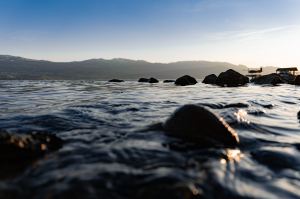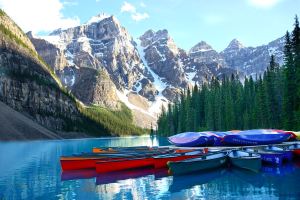Vancouver to Banff | The Perfect Road Trip

Canada has some of the most beautiful scenery in the world and the places to hike, swim, sightsee and photograph are endless. The Rocky Mountains, from Vancouver to Banff are a highly sought after region for the adventurer and especially the photographer.
The best news? The drive is half the fun. With epic backdrops and winding roads through the mountains (go slow and have the right tires!), the journey itself is a remarkable experience.
You could spend months exploring everything the west coast of Canada has to offer, but most people don’t have months. For a perfect road trip, stick with Vancouver to Banff.
Luckily, a lot of major hot spots are relatively close to one another If you can get ten days to two weeks off, you’re in for a treat. If you’re planning on going in winter, awesome. That being said, allow at least a few extra days for weather. The roads are very dangerous in inclement weather.
4 Places to Hit on the Way to Banff
Kelowna: Wine Country: Day 1-2

Kelowna is known as BC’s Wine country
People always mention Banff as a great destination, and here’s how to get from Vancouver to Banff and enjoy every step along the way. Start by heading south through Vancouver, head east From Whistler: 508 km (5.5 hours)
Setting Kelowna as your first destination is a great idea. It gets a good chunk of the driving done without dragging on too much. Arrive in the early afternoon, enjoy a winery tour (or multiple). Sleep in and grab brunch. When you get there, your reward is copious amounts of wine. Plan to stay over one night. Check out A View To Remember for an affordable B&B that is walking distance to wineries and boasts gorgeous lake views.
Pro Tip: If the lifts are open and there is snow on the ground, consider heading up to Big White. Enjoy champagne powder and ski-out right to the popular bar, Sessions for your apres. Big White is about an hour from Kelowna at 62 km, but the true ski bums will appreciate it.
What about a detour? If wine isn’t your thing, you’re a bit more crunched for time or Kelowna is missable for you, head straight to Kamloops. Kamloops is a good one day/night stopover as it breaks up the distance from Vancouver to Banff as a good halfway mark. You can rug it in a trailer or go high end. If you want to get active, you certainly can.
Get Stoked on Revelstoke: Day 2-3
Distance from Kelowna: 197 km, 2.5 hours
If you leave Kelowna (okay…early-ish after the wine) and get to Revelstoke by early afternoon, you can be on your way the following day (unless you’re skiing, then take a full day).
Take the road up the mountain called “Meadow in the Sky Parkway.” Enjoy panoramic views of the town and branch off to multiple shorter or longer hikes. If you’re lucky, the road to the very top will be open and you can venture up to the massive flower garden.
Again, if you’re making the epic adventure from Vancouver to Banff in the snowy months, spend a day on the lifts.
Glacier National Park: Spend It Secluded, Day 3
Distance from Revy: 30 minutes, 46km
One-night camping in Waitabit, for total seclusion and surreal views. Ideal for the minimalist. Head to Glacier National Park refreshed from Revy and ready to lose wi-fi. Bring toilet paper! There are numerous hikes and lots of wildlife, including bears, elk, moose and even wolves.
Yoho National Park Day 3-4
Distance from Glacier NP: 1 hour, 80 km.
Waterfalls, fossil beds, hikes and camping. Much like all the National Parks, Yoho is a spectacular stop. Emerald Lake, aptly named for its spectacular colour takes the cake in Yoho, so if you don’t have time for the multiple hikes, make sure you see this one for yourself.
Detour: Radium Hot Springs 1.5 hours from Yoho National Park
If time is not of the essence, the Radium Hot Springs are worth making a quick detour. Situated on the edge of Kootenay National Park, the quaint village of 776 people is sure to charm. Known for bringing peace, it’s the perfect mid-trip relaxing stop.
Banff: The Destination Day 4-7

This is the picture perfect destination you’ve been waiting for.
Distance from Yoho National Park: 45 minutes, 66 km
Distance from Radium Hot Springs: 1 hour 40 minutes, 135 km
The lakes in Banff are some of the most stunning in the world. With mountainous backdrops and piercing turquoise lakes, you’ll feel like you’re looking at a painting. There is a reason everyone flocks to these destinations, cameras in hand.
If you know anyone who has been to Banff, you’ve likely heard them talk about (or seen on their Instagram) Moraine Lake and Lake Louise, undoubtedly the two most famous, and for good reason. Puzzlingly enough, the lakes are actually a short drive from the city centre of Banff, where you’d likely stay. It’s a lazy, cute town with lots to do and will very busy in the summer.
- Lake MoraineOne hour from Banff, it speaks for itself with its beauty. Just go. If you’re not a hiker or need a break, take it at Moraine. Save the hike for Lake Louise tomorrow!
Pro Tip: Everyone wants to see the lakes, but not everyone is willing to get up at 5 am. If you want the best lunch spot or the selfie without any photo-bombers, go early. The serenity and the sunrise will be well worth it.
- Lake Louise Another classic Banff icon, there are tons of hikes to do surrounding Lake Louise. Only 40 minutes from the city centre, there’s no excuse to miss the sunrise! Mirror Lake hike will take you to a stunning lookout. If you’re feeling ambitious, take the 9km uphill trek up to Big Beehive.
Icefield Parkway to Jasper: Three Must-Dos, Day 7-10
Okay, so now you’re an expert on how to get from Vancouver to Banff and what to do along the way, but the adventure isn’t over! The Icefield Parkway is the stretch between Banff and Jasper, about 230 km winding through ancient glaciers and the most beautiful backdrops you could ask for. If you have the time, you can stop off at the 10,000-year-old Athabasca Glacier to explore.
- Peyto Lake Just over an hour from Banff (100 km), Peyto Lake can be a quick stop but is very worth making. A short walk leads you to the viewpoint of the incredible lake.
- Jasper: Maligne Canyon Walk Jasper is a laid back town with a chilled out vibe. The Maligne Canyon walk is a unique and beautiful experience. As with all the best places, it gets busy. Go early or go late to avoid crowds.
Pro Tip: Jasper is one of the best places in Canada to see the Northern Lights because of its dark sky preserves. The best time to see them is October-May. Jasper National Park in October is a great option. Grab a coffee, blanket and camera and cross your fingers mother nature will put on a show!
- Mount Robson Provincial Park For the avid hiker, nature lover or anyone looking for a challenge, Mount Robson Provincial Park is perfect for you. Only 20 minutes from Jasper, the park boasts diverse ecosystems, cascading waterfalls, glacier-fed pools and hikes of varying difficulties as well as campgrounds to rest your weary legs.
Heading Home: Stops to Make, Day 10-13

One more worthy stop on your way home – Wells Gray Provincial Park
You can make the trip back to Whistler in about eight hours if you’re pressed for time, but if you have a few extra days, the magic doesn’t have to be over. Why not stay in Clearwater and visit Wells Gray Provincial Park?
Clearwater is the town that houses Wells Gray Provincial Park and is also home to many waterfalls and hikes. It is about five and half hours from Whistler (423 km), so stopping here makes for a relatively quick drive home.
Pro-tip: Where to condense: The above itinerary is an (awesome) suggested timeline for Vancouver to Banff and beyond, but is just that: a suggestion. Your trip can be amazing even if you don’t have a ton of time. If you’re looking to cut a few days, get up early and get going! You could do Banff for two days instead of three. Cut out a hike or two and do Jasper in two. You can still fit everything in, just be ready to be go-go-go!
Grab your map (iPhone), best company, camera and charger and lots of snacks and get ready for the best road trip ever! Gas can get expensive, so the more friends that can come along the better for splitting costs. Have everyone decide on their top excursion they want to do and make sure you have time to incorporate them all!
…
Road trips do not always go as planned, so remember to bring extra snacks and water, have seasonally appropriate tires, and tell a friend your general route. It’s also not a bad idea to have BCAA (British Columbia Roadside Assistance) in case you have any car troubles. Most importantly though? A good playlist.
